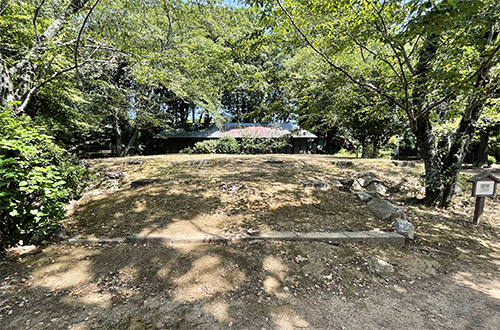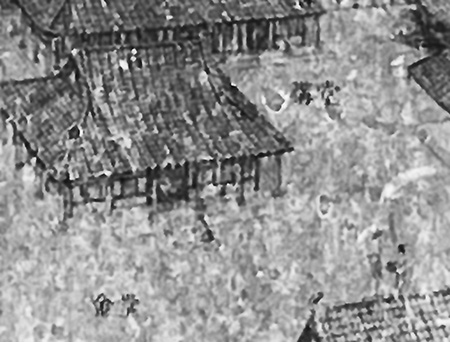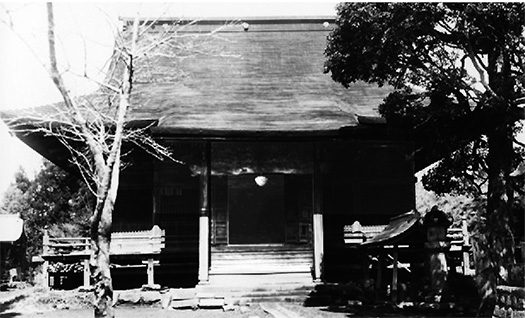

龍角寺の発掘研究については早稲田大学が積極的に関与して、その成果を資料として公開してきている。2022年10月開催の早稲田文化芸術週間2022において「下総龍角寺展関連シンポジウム」が開かれ、その発表がまとめられて公開されている。
この龍角寺の建立、そしてそれに先立つ古墳群氏族が繁栄していた地域名として古代の「印波」という地名が資料に見える。(千葉県立房総のむらの研究者・白井久美子氏論文より)
氏の論考では龍角寺古墳群の歴史時期は「飛鳥に宮殿が置かれた「飛鳥時代」前期、国を挙げて中国隋・唐王朝の律令制度にならった新たな体制に転換する時代にあたる。また、異国の宗教であった
仏教を本格的に取り入れた時期でもあった。」とされている。
法隆寺の創建が607年とされる。一方この龍角寺は寺伝では創建年は709年とされるが、650年から660年頃に創建されたとの説を唱える研究者もいる。本尊の頭部制作年もその時期とされる。
この「印波」という地名からその氏族名を仮定すれば、印波氏というのは、関東の地方豪族として群馬県上野(こうづけ)の上毛野(かみつけの)氏とも比肩できるような氏族だったと思える。上毛野氏は歴史年代での浅間山火山噴火で大打撃を受けて地域崩壊したと想像できるけれど、この仮称・印波氏もあまり資料に見られない。印波国造時代からこの地域有力豪族と思えるが資料が少ない。
この龍角寺の創建には地域豪族としてスポンサーとなったことが推定できるが、寺伝にも龍の頭蓋骨のようなお伽噺はあっても、氏族名を証するものはないようだ。
想像すれば、古代の国名特定(令制国)のときにこの一帯地域は国名として「下総」という地名になっていったけれど、その国名が一般化するなかで氏族名も衰退していったのだろうか。令制国の成立時期は早ければ大化元年(645年)遅くとも大宝元年(701年)とされるので、どうもこの龍角寺の創建年代とも符合してくる。中央と鄙の関係性も関わってくるか。


上の写真のように江戸期に建築された金堂の古写真(昭和7年当時)が早稲田大学でのシンポ記録では公開されていた。同シンポでの早稲田大学理工学術院・小岩正樹氏の分析記事。現在の龍角寺境内に置かれた復元図に表された金堂と相似した建築。この古写真の金堂は元禄5年(1692)に罹災したことを受け元禄11年(1698)に建立されたと。昭和25年(1950)に倒壊の危険のため解体された。
1692年以前の龍角寺金堂は、寺伝の709年創建時からのものだったのか不明だけれど、今に残る基壇礎石など、きのう見た塔の礎石のように創建時の設計趣旨に忠実に従うのが日本の匠の伝統と考えられるので、古写真とよく似た建築が歴世、この地にあり続けたと想像できる。
いろいろ想像力が導いてくれる木造の歴史的建築の探訪であります。
English version⬇
The site of “Kondo,” where the platform still remains, Ryukakuji Temple (5): Exploring the Three Shrines of the Eastern Provinces – 12
Research results were presented at the Waseda Symposium. Traces of local powerful families from the Kunizukuri period. The name of the country was changed from “Inba” to “Shimousa” during the establishment of the state under the Order of the Emperor. The name was changed from “Inba” to “Shimousa” in the country under the Order of State.
Waseda University has been actively involved in the excavation and research of Ryukakuji Temple, and the results have been made public in the form of documents, including a symposium related to the Shimousa Ryukakuji Temple Exhibition held during the Waseda Culture and Arts Week 2022 in October 2022.
The ancient place name “Inba” can be seen in the documents as the name of the area where the Ryukaku-ji Temple was built and the preceding tumulus clan flourished. (From an article by Kumiko Shirai, a researcher at Chiba Prefectural Boso no Mura.)
In her discussion, Ms. Shirai states that the historical period of the Ryuzumadera Kofun Tumulus Group was the early Asuka Period, when palaces were established in Asuka and the entire country was converted to a new system based on the Ritsuryo system of the Sui and Tang Dynasties in China. It was also the period when Buddhism, a foreign religion, was introduced in earnest.
It was also the time when Buddhism, which was a foreign religion, was introduced into the country in earnest. The founding of Horyu-ji Temple was in 606.
Horyu-ji Temple is said to have been founded in 607. According to temple tradition, Ryukaku-ji Temple was founded in 709, but some researchers believe that it was built between 650 and 660. Some researchers believe that the temple was founded between 650 and 660, the year when the head of the main image was created.
If we assume the name of the clan from the place name “Inba,” it is likely that the Inba clan was a local clan in the Kanto region, comparable to the Kamitsuno clan of Kozuke in Gunma Prefecture. While the Kamimeno clan was hit hard by the volcanic eruption of Mt. Asama in the historical period and the region collapsed, the Inba clan, as it is tentatively called, is also not well documented. The Inba clan seems to have been a powerful family in this area since the Inba Kunizou period, but there are few data on them.
It can be presumed that they sponsored the construction of Ryukakuji Temple as a local powerful family, but there is no evidence of their clan name in the temple legend, even though there is a fairy tale of a dragon skull.
It is imaginable that the name of this area was changed to “Shimousa” when the ancient name of the country was specified (Reisei Kuni), but as the name of the country became common, the clan names also declined. The date of establishment of the country as a state under the ritsuryo system is said to be the first year of Taika (645) at the earliest, and the first year of Taiho (701) at the latest, so it seems to coincide with the founding date of Ryukakuji Temple. The relationship between the central and remote areas may also have something to do with it.
As shown in the photo above, an old photo of Kondo built in the Edo period (as of 1932) was available in the symposium record at Waseda University. An analytical article by Masaki Koiwa, School of Science and Engineering, Waseda University, at the same symposium. The architecture is similar to the Kondo shown in the restored map placed in the precincts of the present Ryukakuji Temple. The Kondo shown in this old photo was built in 1698 after the temple was damaged in 1692. It was dismantled in 1950 due to the danger of collapse.
It is unclear whether the Ryukakuji Kondo was built before 1692 or in 709, according to the temple’s legend. However, it is considered to be a tradition of Japanese craftsmen to faithfully follow the design intent of the original construction, as seen in the foundation stones of the pagoda we saw yesterday, including the foundation stones of the platform that remain today.
This is an exploration of historical wooden architecture guided by various imaginations.
Posted on 8月 16th, 2023 by 三木 奎吾
Filed under: 日本社会・文化研究, 歴史探訪







コメントを投稿
「※誹謗中傷や、悪意のある書き込み、営利目的などのコメントを防ぐために、投稿された全てのコメントは一時的に保留されますのでご了承ください。」
You must be logged in to post a comment.